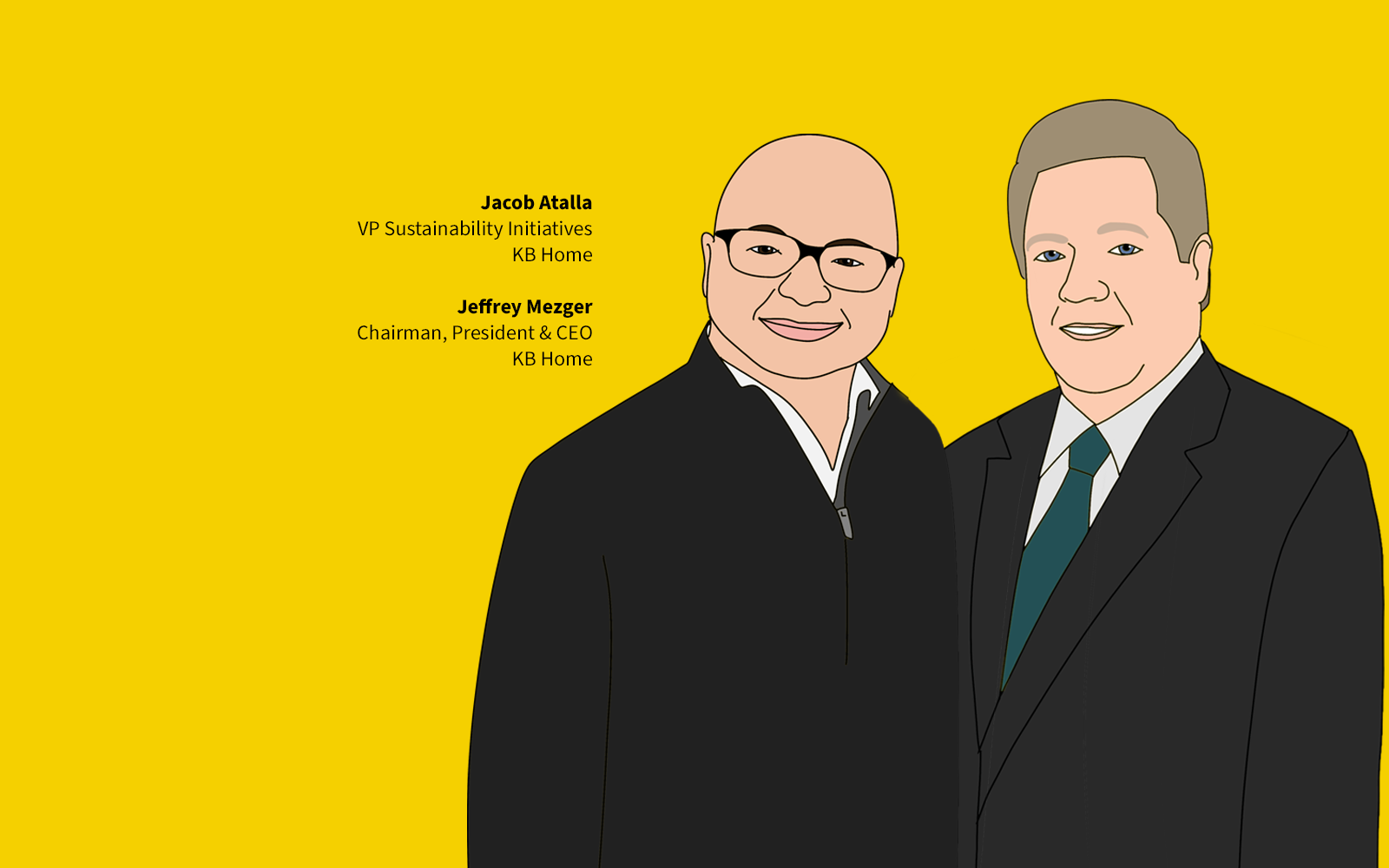Leadership
Fire-Ready Future Forward: KB Home Builds Hardened Homes At Scale
Escondido, CA-area’s Dixon Trail becomes the nation’s first IBHS-certified Wildfire Prepared Neighborhood—fusing resilience, affordability, and innovation into a new model for community design.

Since people began building shelter, a home’s deepest value has been its ability to protect—offering a safe place from the dangers outside, a source of comfort, and a backdrop for lives, memories, and peace of mind.
Today, in a time of fast-rising costs, finite natural resources, and increasingly unpredictable natural hazards, delivering on that timeless promise—safety, comfort, and peace—has never been harder. Homebuilders face mounting pressure to reconcile affordability with sustainability, resilience, and livability. Most developers lean into one or two of those pillars. Few strive to do all four.
KB Home has made it its business — as a trusted brand and as a business culture — to stand as an exception.
For much of its journey spanning eight decades, KB Home has committed to investing in innovation — not for show, but to solve real-world problems for real families. From pioneering affordable slab-on-grade homes in the 1950s to building all-solar and all-electric micro-grid neighborhoods in the past decade, the company has often stepped forward early into the future, one house at a time.
Its latest leap: a first-of-its-kind wildfire-resilient community in Escondido, California, where 64 homes will rise as part of the Dixon Trail neighborhood. The homes—engineered to withstand embers, radiant heat, and direct flames—represent the nation’s first application of a new neighborhood-level wildfire certification developed by the Insurance Institute for Business and Home Safety (IBHS), an independent nonprofit that’s been researching fire resilience for over a decade.
It’s in our DNA at KB Home to keep evolving our homes as solutions for our residents’ and neighbors’ life challenges today and tomorrow,” Jacob Atalla, KB Home’s Vice President for Sustainability and Innovation, tells The Builder’s Daily.
That evolution has brought KB Home to this moment — where the design and construction of every single home, and the layout of the neighborhood itself, are informed by the realities of climate-driven wildfire risk.
A Model for the Future
Each home at Dixon Trail will be built to the Wildfire Prepared Home™ Plus standard from IBHS, the highest designation available. That means Class A fire-rated roofing, noncombustible gutters, ember- and flame-resistant vents, upgraded windows and doors, and a 5-foot noncombustible perimeter buffer around the house.
What’s new—and potentially transformative—is that the entire neighborhood has also been designed to reduce risk at the community scale. Fire-resistant fencing and landscape materials, generous separation between structures, and reduced fuel pathways help prevent embers from jumping and fires from spreading house to house.
Once the community is completed and passes final IBHS evaluation, it will receive the first-ever Wildfire Prepared Neighborhood™ designation.
As KB Home’s senior leaders see it, resilience is a continuation of the company’s long arc of innovation—not a detour. Jeffrey Mezger, Chairman and Chief Executive Officer of KB Home, says in a prepared statement:
In keeping with our tradition of innovation, we are pleased to offer today’s buyers the ability to choose a wildfire-resilient home and community. We are proud that our new Dixon Trail community, with its system of mitigation features, is the first in the nation to meet IBHS’s wildfire resilience standards at the homesite level and at the neighborhood level.”
Behind each of its transformative initiatives—from energy and water efficiency to wildfire preparedness—KB Home follows a consistent playbook: partner widely and collaborate deeply.
Whether with IBHS, utility providers, water resource agencies, municipal planning authorities, building code experts, or long-time manufacturer and trade partners, KB Home works shoulder-to-shoulder across sectors to evolve its design, engineering, and construction practices. It’s a systems-level strategy—driven by the belief that no single organization can solve today’s complex housing challenges alone.
We never do this work in isolation,” Atalla tells us. “Our role is to connect the dots between science, policy, infrastructure, and construction, and then turn that into something that delivers real value to the families who live in our homes.”
The Science Behind the Standard
The work behind that designation traces back to one of the most advanced weather hazard testing facilities in the world. Headquartered in Richburg, South Carolina, the IBHS Research Center houses a 21,000-square-foot chamber capable of recreating full-scale windstorms, hail strikes, wind-driven rain, and wildfire ember exposures.
Founded in 1977 and funded by the property-casualty insurance industry, IBHS represents nearly 80% of all residential property insurance sold in the U.S. The organization’s mission is simple: to identify and help eliminate avoidable loss from extreme weather. Their building science research, rooted in controlled lab tests and real-world post-disaster analysis, powers the designations that help insurers, policymakers, and builders better protect homes and communities.
In addition to wildfire programs, IBHS also manages the widely adopted FORTIFIED™ Home standard for wind mitigation. Its Wildfire Prepared Home designation launched in 2022 and has already received more than 7,200 applications, with over 1,200 homes completing the full certification process.
For a new-home community, building from the start to a standard like this is much easier than retrofitting later,” said Steve Hawks, IBHS’s Senior Director for Wildfire. “And KB Home was in a spot where they were ready to go. They were close to starting the development when we connected with them through the California Building Industry Association, and they quickly latched onto the program.”
Hardening Homes And Neighborhoods Works
California’s new wildfire zone maps—released just this week by CAL FIRE—are expected to bring more areas under stricter development oversight. For homebuilders, developers, and land sellers, that means more scrutiny, higher insurance premiums, and potentially stalled projects. But innovations like Dixon Trail offer a path forward.
This project shows that it’s achievable,” said Hawks. “We know from our research, and from post-fire analysis, that these actions work. When you implement them, they can have a positive impact on narrowing the path to conflagration.”
That’s not just theory. It’s hard-earned knowledge born from the devastation of fires like the Camp Fire in Paradise, the Woolsey Fire in Los Angeles, and more recently, the destruction in Lahaina, Hawaii. In almost every catastrophic fire event, a small set of high-wind, high-heat wildfires are responsible for the vast majority of structure loss.
It’s a very small percentage of wildfires—less than 1%—that result in over 95% of structure losses,” said Hawks. “That’s the scenario we’re trying to defend against. You build each individual home to withstand embers, flames, and radiant heat. Then you do it across the entire community. That gives the homes and the neighborhood the best chance of survival.”
Trade-Offs No Longer
In many parts of the country, the word “trade-off” is an unavoidable part of the development conversation. Want affordability? Maybe you have to give up some resilience. Want sustainability? It might cost too much. Want community-wide safety? You may lose density.
KB Home’s Dixon Trail community doesn’t ignore those tensions—it answers them differently.
We had to adjust from our typical specs,” said Atalla. “But we didn’t wait to announce it until we were sure the homes would be delivered and the designation was confirmed. We wanted the community to be ready.”
That attention to timing, execution, and neighborhood design is part of KB Home’s larger philosophy. Its sustainability milestones speak volumes:
- First ENERGY STAR® certified home in 2000
- First national builder to make ENERGY STAR® a standard across all homes in 2008
- First to offer WaterSense® labeled homes in 2010
- All-solar communities in 2011
- The first to adopt the EPA’s highest water-efficiency standards in drought-prone regions in 2022
- Over 200,000 ENERGY STAR homes delivered by 2024—more than any other builder
This is just the next step,” Atalla said. “We’re looking at homes that are safer, more energy- and water-efficient, and resilient. That’s not a checklist—it’s a responsibility.”
For the Industry: A Signal, Not a One-Off
For fellow builders, developers, and capital partners navigating the increasingly difficult terrain of housing supply, insurance pressures, regulatory constraints, and climate risk, Dixon Trail isn’t just a case study. It’s a signal.
The IBHS Wildfire Prepared Home and Neighborhood programs are scalable. They’re not just for 64 homes in Escondido. They’re being piloted in Oregon. More builders are expressing interest. And the insurance industry is taking note.
Without this kind of action, we’ve seen the results,” said Hawks. “We know what happens when vulnerable communities don’t do the mitigation. But when they do, homes become more insurable. They stand a chance. And people have a home to return to.”
At the 2025 PCBC conference, IBHS and KB Home will jointly present a live wildfire demonstration—another chance for the industry to see up close what resilient construction looks like. Hawks won’t be there in person, but his message is clear: resilience isn’t optional.
This initiative isn’t just about wildfire,” he said. “It’s about future-proofing homes—against climate, cost, and whatever comes next.”
MORE IN Leadership
10 Bold Ideas Tackling Housing Affordability And Access Now
From AI to hempcrete, these 10 ideas show how innovation in design, finance, and policy can open the door to housing affordability.
Sumitomo Forestry Sharpens U.S. Focus With DRB Move
Strategic clarity replaces portfolio sprawl as Sumitomo bets big on U.S. scale and integration.
Homebuilders and Insurance: A New-Reality Cost To Stay Ahead
Exclusive insights from Westwood Insurance Agency’s Alan Umaly and MSI’s Naimish Patel reveal why homebuilders must rethink insurance, resilience, and risk management—or risk losing buyers in an increasingly volatile market.
